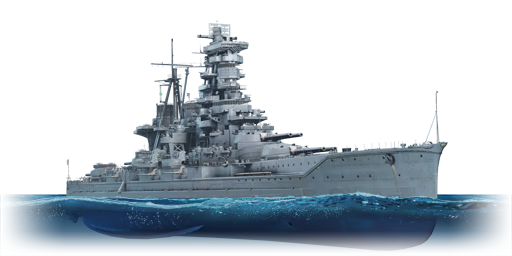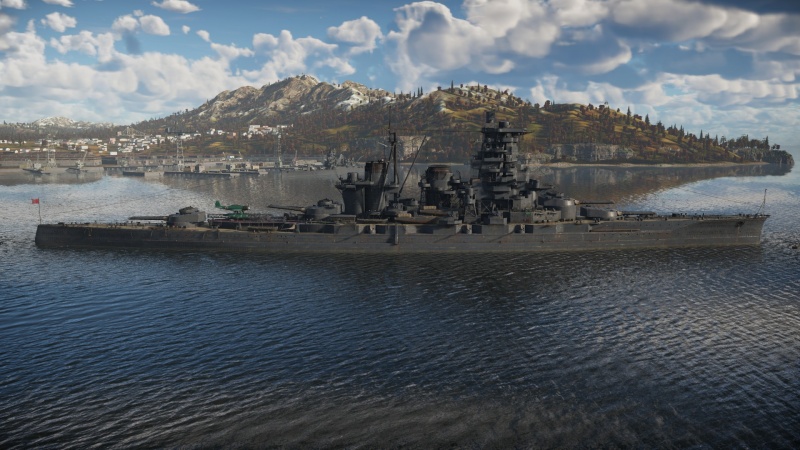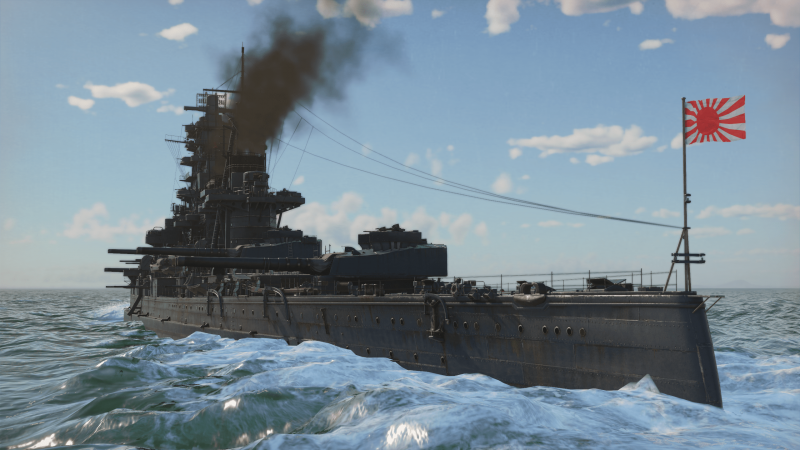IJN Haruna
Contents
Description
The Kongo-class, IJN Haruna, 1945 (榛名, namesake: Mount Haruna) was the fourth and last Kongō-class battlecruiser (later classed as a fast-battleship by the IJN), being commissioned in 1915 on the same day as her sister ship, Kirishima. Participating in almost every major naval action in the Pacific conflict, she sailed with the southern fleet in preparation of the battle of Singapore, covered the Japanese landings in Malaya and the Dutch East Indies, engaged in the battle of Midway and fought in the Guadalcanal Campaign. From 1943 onward she would primarily move between bases as escort and cover for withdrawals and transfers. She would sink in the port of Kure Naval Base after several days of bombardment by Task Force 38 on 28 July 1945.
Haruna was introduced during Update "Danger Zone" as a reward for the 2022 Summer Quest event. Being in her last refit, she carries more anti-air 25 mm barrels than her sister Kongo, resulting in a larger volume of fire against mid-close range aerial attacks. Otherwise, Haruna offers decent mobility for the main armament she boasts at the cost of maximum armour; this speed can greatly enhance her effectiveness in Enduring Confrontation battles compared to other battleships.
General info
Survivability and armour
At first glance, Haruna's protection is similar to that of her sister ship Kongo. Being originally commissioned as a battlecruiser, Haruna's armour is quite underwhelming for a capital ship. Despite the Japanese reclassification as a battleship, for all intents and purposes, this vessel still plays like a battlecruiser and can be considered as such. Though relatively thin, the armour still offers extensive protection against cruiser calibre gunfire and the occasional battleship shell, when angled. However, the devil hides within the details, as Haruna has a different crew distribution compared to Kongo, with roughly 80% of her crew being located in the midship section, and 40% of them were positioned inside a vulnerable deck of the ship. This results into her being more vulnerable to hits in that area, potentially even from cruisers.
Due to the placement of her third turret close to that vulnerable deck, it has a risk of catching fire from repeated HE salvos which can spread down into the shell elevator, possibly resulting in a lethal detonation.
The Haruna will be able to pump out water if the flood control timer stays under 40 seconds. If you reach that threshold, staying afloat will be increasingly difficult.
Mobility
The Kongo-class's nature as a battlecruiser reflects in Haruna's speed, which is a very good 56 km/h. As a FBB this is only slightly less than most cruisers, and is leaps and bounds ahead of the speed of dreadnoughts. However, her acceleration and deceleration are still unexceptional, and her turning is not very good.
| Mobility Characteristics | |||
|---|---|---|---|
| Game Mode | Upgrade Status | Maximum Speed (km/h) | |
| Forward | Reverse | ||
| AB | |||
| Upgraded | 66 | 29 | |
| RB/SB | |||
| Upgraded | 57 | 25 | |
Modifications and economy
Armament
Primary armament
The 36 cm/45 Type 41, also seen on Hyuga, is an exceptional battleship cannon. Compared to the 12 guns of Hyuga, the IJN Haruna gets only 8 guns, but she features a new selection of shells. Her stock shell, Ordinary SAP, is identical to the shell on Hyuga, and certainly gets the job done. With the equivalent of 68.64 kg of TNT, her SAP is still a head and shoulders over even the HE on most other battleships. These shells will smash cruisers whenever they hit, and against battleships, while they will rarely penetrate the main armour plates unless at close range, the splash damage from the detonation will frequently destroy guns and turrets. The shell can also slip through thinner armour plates to cause devastation inside the vessel. Type 91 APC is an improvement over Hyuga's equivalent AP shell, with extra penetration. This shell is mostly used against battleships, where the extra penetration is needed to penetrate the belt armour. The last shell is Type 0 Common, an HE shell. This shell possesses only half the explosive filler of the SAP, however it still has some utility when it comes to destroying coastal vessels and destroyers, given that other armour piercing rounds have a tendency to deal little damage and pass right through smaller unarmoured ships unless they hit a large module, such as the engines.
| Penetration statistics | |||||||
|---|---|---|---|---|---|---|---|
| Ammunition | Type of warhead |
Penetration @ 0° Angle of Attack (mm) | |||||
| 1,000 m | 2,500 m | 5,000 m | 7,500 m | 10,000 m | 15,000 m | ||
| Ordinary SAP | SAPCBC | 301 | 280 | 248 | 222 | 199 | 168 |
| Type 91 APC | APCBC | 635 | 593 | 529 | 476 | 431 | 366 |
| Common Type 0 | HE | 67 | 67 | 67 | 67 | 67 | 67 |
| Shell details | ||||||||||||
|---|---|---|---|---|---|---|---|---|---|---|---|---|
| Ammunition | Type of warhead |
Velocity (m/s) |
Projectile mass (kg) |
Fuse delay (s) |
Fuse sensitivity (mm) |
Explosive mass (TNT equivalent) (kg) |
Ricochet | |||||
| 0% | 50% | 100% | ||||||||||
| Ordinary SAP | SAPCBC | 780 | 635.58 | 0.01 | 26 | 68.64 | 48° | 63° | 71° | |||
| Type 91 APC | APCBC | 771 | 671.3 | 0.05 | 26 | 11.66 | 48° | 63° | 71° | |||
| Common Type 0 | HE | 805 | 621 | 0 | 0.1 | 31 | 79° | 80° | 81° | |||
Secondary armament
Haruna's secondaries consist of eight 15 cm/50 Type 41 cannons, four per side in casemate mounts. Comparable guns can be found on Agano, although these guns can maintain a sustained rate of fire of 10 RPM. While they are 150 mm secondaries, which is fairly large for an auxiliary battery, they are nothing to write home about, as the best shell only has 81 mm of penetration at point blank range. However, the high explosive mass of the SAP round - nearly as good as HE - makes it very well suited for fighting destroyers.
| Penetration statistics | |||||||
|---|---|---|---|---|---|---|---|
| Ammunition | Type of warhead |
Penetration @ 0° Angle of Attack (mm) | |||||
| 1,000 m | 2,500 m | 5,000 m | 7,500 m | 10,000 m | 15,000 m | ||
| Type 0 HE | HE | 35 | 35 | 35 | 35 | 35 | 35 |
| Type 4 SAP | SAP | 81 | 68 | 52 | 40 | 34 | 34 |
| Shell details | ||||||||||||
|---|---|---|---|---|---|---|---|---|---|---|---|---|
| Ammunition | Type of warhead |
Velocity (m/s) |
Projectile mass (kg) |
Fuse delay (s) |
Fuse sensitivity (mm) |
Explosive mass (TNT equivalent) (kg) |
Ricochet | |||||
| 0% | 50% | 100% | ||||||||||
| Type 0 HE | HE | 850 | 45.26 | 0 | 0.1 | 3.17 | 79° | 80° | 81° | |||
| Type 4 SAP | SAP | 850 | 45.26 | 0.01 | 7 | 2.92 | 47° | 60° | 65° | |||
Anti-aircraft armament
Being in a late-war refit, Haruna is outfitted with a ludicrous number of anti-air guns, consisting of twelve 127 mm flak cannons and exactly one hundred 25 mm Type 96 autocannons on board the ship. However, it is worth remembering that they are the infamous Type 96 25 mm gun mounts, which were some of the worst AA cannons of the war, combining a small magazine, lacklustre damage, relatively low elevation and traversal rates, and a poor effective range. Despite this, the sheer number of guns alone allows the Haruna to fend off any aircraft within 3 km range, though due to the short effective range, they can be mostly outranged by high-flying bombers.
Due to the 127 mm being classified as flak turrets, they only have access to an HE-TF shell, somewhat reducing the auxiliary firepower against smaller vessels, though they are capable of putting up a reasonable flak field around inbound aircraft.
As a side note, the numerous gun mounts of the Haruna can be detrimental to Haruna's survival, since they can be easily destroyed and/or catch fire from any HE blasts near it, draining a significant portion of her crew in the process. Because of this, it is recommended not to repair them while under enemy fire.
Scout plane
Located between the aft main turrets is a deck area and catapult for one Aichi E13A1 scout plane which provides additional offensive and defensive options. Ship-launched scout planes fly just like regular tech tree aircraft, but lack munition choices and cockpit views. The E13A1 is equipped with a 7.7 mm Type 97 defensive machine gun and 4 x 60 kg bombs, a relatively heavy bomb load for a scout plane. It also has the ability to capture zones and lay down a smoke cover (up to 3 times). Captains will be wise to remember to utilise the aircraft and consider when best to use it, for example to cap a point early or late in the match, to create a smoke screen to stymie enemy bombardment and repair, to attack enemy units directly, or perhaps something completely new! Carrying a heavier bomb load than most other scout planes, this plane can potentially sink enemy boats and maybe even destroyers.
Usage in battles
Describe the technique of using this ship, the characteristics of her use in a team and tips on strategy. Abstain from writing an entire guide – don't try to provide a single point of view, but give the reader food for thought. Talk about the most dangerous opponents for this vehicle and provide recommendations on fighting them. If necessary, note the specifics of playing with this vehicle in various modes (AB, RB, SB).
Pros and cons
Pros:
- Exceptional main guns with a very potent SAP round and comfortable gun arcs
- Very fast for her size
- Good AA protection
- Workable armour above waterline; turtleback around the magazines
- Access to floatplanes
Cons:
- Crew is more concentrated around the midship section compared to the sister ship, thus making them vulnerable to concentrated fire
- Extremely weak underwater protection, vulnerable to large calibre diving shots from heavy cruisers or above
- Third turret ammo rack can be detonated in a prolonged fire
- Subject to flooding and capsizing in addition due to aforementioned weakness
- 127 mm batteries are categorized into AAA group and hence no combined manual control or ammo options
History
Devblog
The battlecruiser Haruna of the Kongō class was laid down in 1912 and commissioned in 1915. During the First World War, she did not see active combat. Before the start of World War II, the ship went through two modernization programs, during which Haruna was reclassified as a fast battleship, the combat potential of the ship was significantly increased and it became possible to use it to escort Japanese aircraft carriers. During the invasion of mainland China in 1937, the battleship Haruna was used to transport troops. The battleship fought the first battle of World War II in December 1941 in the Battle of Kuantan against the Royal Navy. She then was active in the area of the Malay Archipelago in operations to invade Borneo and the Dutch East Indies, going on to participate in the attack on Ceylon. In May 1942, after serving in dock, she joined the carrier group in the Battle of Midway, after which the ship took part in the Battle of Guadalcanal. During all the time of intense fighting, Haruna did not receive any significant damage. In October 1943, the battleship was sent to defend Wake Island from American attacks. In the Battle of the Philippine Sea, Haruna received two hits with armor-piercing bombs, repairs lasted until the autumn of 1944. After the Battle of Leyte Gulf, the battleship was damaged when running aground on a coral reef. While docking at the naval arsenal in Kure in July 1945, the ship participated in the defense of the base, but as a result of air raids, Haruna received several hits from American bombers in a few days and sank.
Media
- Skins
- Videos
See also
External links
| Kawasaki Shipyard Co. (川崎造船) | |
|---|---|
| Destroyer Escorts (DE) | |
| Ikazuchi-class | Ikazuchi |
| Heavy Cruisers (CA) | |
| Furutaka-class | IJN Kako |
| Battleships (BB) | |
| Kongō-class | IJN Haruna* |
| Ise-class | IJN Ise |
| Notes | *Initially laid down as battlecruiser, later modified and reclassified as (Fast) Battleship (FBB). |
| See also | Kawasaki Aircraft Industries |
| Japan battleships | |
|---|---|
| Kawachi-class | IJN Settsu |
| Fusō-class | IJN Fuso · IJN Yamashiro |
| Ise-class | IJN Ise · IJN Hyuga |
| Kongō-class | IJN Kongo · IJN Haruna |
| Nagato-class | IJN Mutsu |






